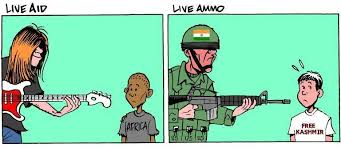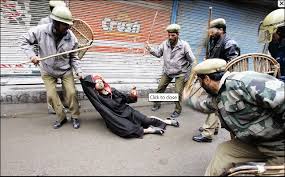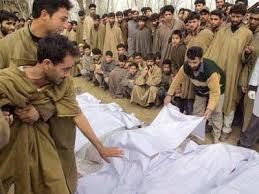Appeasement taken as sign of docility
Asif Haroon Raja
BRUTAL IMAGES OF INDIAN ARMY’S GENOCIDAL ATROCITIES IN JAMMU & KASHMIR REGION
UNDER INDIAN OCCUPATION






Nawaz Sharif addressed the UN Assembly on 27th and in that he jogged the memory of the UNSC by reminding it of its responsibility to resolve the 66 year old Kashmir dispute in accordance with the UN resolutions. He also called upon the international community to play its due role for the realization of the right of self-determination of the Kashmiri people and let them decide their future through a plebiscite organized by the UN. Nawaz thus rekindled the age-old stance of Pakistan, which Gen Musharraf had gratuitously sabotaged in 2003 to please India and USA. Nawaz’s statement on Kashmir was not to the liking of India. It had been lobbying hard to restrain him from re-enacting the UN resolution stance smothered by Musharraf.
 Known for doing its homework, India on one hand had intensified diplomatic efforts to woo Nawaz after he took over power in early June 2013, and at the same time prepared ground to paint Pakistan and freedom movement in Kashmir in black through carefully planned false flag operations and hate offensive. The first of its kind was the deliberate heating up of Line of Control (LoC) in Kashmir in early January 2013. The incident of beheading of two Indian soldiers allegedly by Pak soldiers was drummed up and dragged on for quite some time. Hostile reaction to the death of Indian RAW agent Sarabjit Singh in April 2013 in the form of killing of Pakistani national Sanaullah Ranjay in Jammu jail tensed Indo-Pak relations. The LoC was one again heated up in August on the pretext that five Indian soldiers had been killed deep inside Indian occupied Kashmir (IOK) by Kashmiri terrorists dressed in Pak uniforms and backed by Pak Army.
Known for doing its homework, India on one hand had intensified diplomatic efforts to woo Nawaz after he took over power in early June 2013, and at the same time prepared ground to paint Pakistan and freedom movement in Kashmir in black through carefully planned false flag operations and hate offensive. The first of its kind was the deliberate heating up of Line of Control (LoC) in Kashmir in early January 2013. The incident of beheading of two Indian soldiers allegedly by Pak soldiers was drummed up and dragged on for quite some time. Hostile reaction to the death of Indian RAW agent Sarabjit Singh in April 2013 in the form of killing of Pakistani national Sanaullah Ranjay in Jammu jail tensed Indo-Pak relations. The LoC was one again heated up in August on the pretext that five Indian soldiers had been killed deep inside Indian occupied Kashmir (IOK) by Kashmiri terrorists dressed in Pak uniforms and backed by Pak Army.
 From August 2013 onwards, hardly a day has passed when Indian occupation forces didn’t violate 2003 peace agreement in Kashmir by resorting to unprovoked firing and killing civilians and soldiers. Just a day before Manmohan’s address in the UN Assembly on 28thSeptember, another terror attack was stage-managed on a military target in Samba. Samba incident, coupled with previous incidents equipped Manmohan with sufficient grist to lambast Pakistan during his speech in the General Assembly. He dubbed Pakistan as an epicenter of terrorism and accused it of abetting terrorism in IOK. He also repeated India’s age-old stance that Kashmir is the integral part of India.
From August 2013 onwards, hardly a day has passed when Indian occupation forces didn’t violate 2003 peace agreement in Kashmir by resorting to unprovoked firing and killing civilians and soldiers. Just a day before Manmohan’s address in the UN Assembly on 28thSeptember, another terror attack was stage-managed on a military target in Samba. Samba incident, coupled with previous incidents equipped Manmohan with sufficient grist to lambast Pakistan during his speech in the General Assembly. He dubbed Pakistan as an epicenter of terrorism and accused it of abetting terrorism in IOK. He also repeated India’s age-old stance that Kashmir is the integral part of India.
Manmohan continued with his laments when he met President Obama on 29 September. He had nothing else to talk except for bad mouthing Pakistan and painting India as the victim of terrorism. Receptive Obama not only shared his concerns compassionately but also approved his boxful of lies without being given shred of evidence. Manmohan’s invectives were meant to 
 put Nawaz on the defensive during his meeting with him on the sidelines of the UN Session on the 30th. Indian foreign minister added to the disinformation campaign by giving lies-filled interview to anti-Pakistan VOA.
put Nawaz on the defensive during his meeting with him on the sidelines of the UN Session on the 30th. Indian foreign minister added to the disinformation campaign by giving lies-filled interview to anti-Pakistan VOA.
Musharraf caused greatest damage to the cause of Kashmir by allowing India to fence the LoC, bridling Jihadist groups, pushing aside UN resolutions on Kashmir and suggesting out of box four-point formula to resolve the dispute. However, ZA Bhutto too had harmed the Kashmir cause during Simla talks in 1972 by agreeing to convert ceasefire line in Kashmir, demarcated on January 1, 1949 into LoC and accepting Indian suggested policy of bilateralism. Concept of LoC encouraged India to focus on converting it into permanent border between two Kashmirs at a later date. Bilateralism enabled India to rule out third party intervention. Gen Musharraf was fully geared to sell off Kashmir by agreeing to implement India’s suggestion of making LoC a permanent border and making the border soft so as to allow two-way trade and facilitate movement of Kashmiris across the border. To that end, bus service between Srinagar and Muzaffarabad was introduced.


 By early 2007, 90% work had been completed through backdoor diplomacy pursued by Foreign Minister Khursheed Kasuri and Advisor Tariq Aziz. Sudden eruption of lawyer’s movement after the sacking of Chief Justice Iftikhar by Musharraf in March 2007, which put Musharraf on the back foot, derailed the process. But for India’s chronic habit of haggling and suspicion, the unholy deal might have materialized by end 2007. Lawyer’s movement proved to be a blessing in disguise for the Kashmiris and Pakistan, but India lost the chance of century to legalize its hold over two-thirds Kashmir. Indian leaders are yearning to re-start the backchannel diplomacy and to pick up threads from where discussion on Kashmir had been abandoned in 2007. Zardari regime made no efforts to remove the stigma of terrorism pinned on Kashmiris or to revive the resistance movement but he didn’t promote Musharraf’s wonky out-of-box concept.
By early 2007, 90% work had been completed through backdoor diplomacy pursued by Foreign Minister Khursheed Kasuri and Advisor Tariq Aziz. Sudden eruption of lawyer’s movement after the sacking of Chief Justice Iftikhar by Musharraf in March 2007, which put Musharraf on the back foot, derailed the process. But for India’s chronic habit of haggling and suspicion, the unholy deal might have materialized by end 2007. Lawyer’s movement proved to be a blessing in disguise for the Kashmiris and Pakistan, but India lost the chance of century to legalize its hold over two-thirds Kashmir. Indian leaders are yearning to re-start the backchannel diplomacy and to pick up threads from where discussion on Kashmir had been abandoned in 2007. Zardari regime made no efforts to remove the stigma of terrorism pinned on Kashmiris or to revive the resistance movement but he didn’t promote Musharraf’s wonky out-of-box concept.
 Nawaz is no less a lover of India than Musharraf and Zardari. Ever since he took over, he has been bending over backwards to win the affections of lame duck Manmohan who will be off the Indian political radar for good after next elections in India due in May 2014. He nostalgically recalls that he had developed deep understanding with Vajpayee. He naively believes that Vajpayee’s historic bus yatra to Lahore in February 1999 had brought the Kashmir dispute to near resolution point, but before the final leap could be undertaken to ink the momentous treaty, Musharraf incapacitated the progress achieved by stepping into Dras-Kargil. He is eager to restart the dialogue with India from where the process broke off in 1999. I reckon, Nawaz has a memory lapse. No sooner Vajpayee had returned to New Delhi, he blurted out that Kashmir is the Atoot-Ang of India and there can never be any compromise on it. Manmohan also reiterated the same stance in his September 28th speech. It implies that the standpoint of the two mainstream political parties on Kashmir is the same.
Nawaz is no less a lover of India than Musharraf and Zardari. Ever since he took over, he has been bending over backwards to win the affections of lame duck Manmohan who will be off the Indian political radar for good after next elections in India due in May 2014. He nostalgically recalls that he had developed deep understanding with Vajpayee. He naively believes that Vajpayee’s historic bus yatra to Lahore in February 1999 had brought the Kashmir dispute to near resolution point, but before the final leap could be undertaken to ink the momentous treaty, Musharraf incapacitated the progress achieved by stepping into Dras-Kargil. He is eager to restart the dialogue with India from where the process broke off in 1999. I reckon, Nawaz has a memory lapse. No sooner Vajpayee had returned to New Delhi, he blurted out that Kashmir is the Atoot-Ang of India and there can never be any compromise on it. Manmohan also reiterated the same stance in his September 28th speech. It implies that the standpoint of the two mainstream political parties on Kashmir is the same.
If so, one wonders why our leaders continue to chase rainbows and hope against hope that India would change its position. Why they have so much faith in composite dialogue which started in 1997? Except for some futile CBMS like people-to-people-contact and trade, no progress could be made on any of the disputes of Kashmir, Siachin, Sir Creek and water. One fails to understand why our leaders are so naïve and myopic to repeatedly come under the magic spell of Indian leaders and get duped? What is their compulsion, and if there is any, why don’t they share it with the people rather than misleading them and leading them up the garden path that friendship with India would not only solve core issues but also make Pakistan prosperous?
If India unscrupulously cooks up stories, engineers false flag operations, insults Pakistan, makes false allegations and threatens Pakistan and whips up war hysteria, why our elected leaders do not pick up courage to call a spade a spade and expose India’s terrorism against Pakistan and massive human rights violations in IOK? Pakistan’s apologetic and defensive policy pursued in the vain hope of appeasing ever belligerent India has proved very costly. It has allowed India to carryout one-sided propaganda and to blame Pakistan for the sins committed by India’s rogue elements against Pakistan. In our quest for peace with India, our leaders have gone an extra mile to please fire-breathing and hate-mongering Indian leaders and in the process have compromised the security, honor and dignity of the country.
Our policy of appeasement is taken as a sign of docility and weakness and exploited. Friendship with India should not be at the cost of losing Kashmir and our dignity and sovereignty of the State. Pakistan will have to make its political, diplomatic and media policies pragmatically offensive to match Indo-US-western-Jewish propaganda spiteful onslaughts duly complemented by segment of our own media.
The writer is a retired Brig, defence analyst, columnist and book writer. asifharoonraja@gmail.com




Appeasement taken as sign of docility
Appeasement taken as sign of docility
Asif Haroon Raja
BRUTAL IMAGES OF INDIAN ARMY’S GENOCIDAL ATROCITIES IN JAMMU & KASHMIR REGION
UNDER INDIAN OCCUPATION
Nawaz Sharif addressed the UN Assembly on 27th and in that he jogged the memory of the UNSC by reminding it of its responsibility to resolve the 66 year old Kashmir dispute in accordance with the UN resolutions. He also called upon the international community to play its due role for the realization of the right of self-determination of the Kashmiri people and let them decide their future through a plebiscite organized by the UN. Nawaz thus rekindled the age-old stance of Pakistan, which Gen Musharraf had gratuitously sabotaged in 2003 to please India and USA. Nawaz’s statement on Kashmir was not to the liking of India. It had been lobbying hard to restrain him from re-enacting the UN resolution stance smothered by Musharraf.
Manmohan continued with his laments when he met President Obama on 29 September. He had nothing else to talk except for bad mouthing Pakistan and painting India as the victim of terrorism. Receptive Obama not only shared his concerns compassionately but also approved his boxful of lies without being given shred of evidence. Manmohan’s invectives were meant to
 put Nawaz on the defensive during his meeting with him on the sidelines of the UN Session on the 30th. Indian foreign minister added to the disinformation campaign by giving lies-filled interview to anti-Pakistan VOA.
put Nawaz on the defensive during his meeting with him on the sidelines of the UN Session on the 30th. Indian foreign minister added to the disinformation campaign by giving lies-filled interview to anti-Pakistan VOA.
Musharraf caused greatest damage to the cause of Kashmir by allowing India to fence the LoC, bridling Jihadist groups, pushing aside UN resolutions on Kashmir and suggesting out of box four-point formula to resolve the dispute. However, ZA Bhutto too had harmed the Kashmir cause during Simla talks in 1972 by agreeing to convert ceasefire line in Kashmir, demarcated on January 1, 1949 into LoC and accepting Indian suggested policy of bilateralism. Concept of LoC encouraged India to focus on converting it into permanent border between two Kashmirs at a later date. Bilateralism enabled India to rule out third party intervention. Gen Musharraf was fully geared to sell off Kashmir by agreeing to implement India’s suggestion of making LoC a permanent border and making the border soft so as to allow two-way trade and facilitate movement of Kashmiris across the border. To that end, bus service between Srinagar and Muzaffarabad was introduced.
If so, one wonders why our leaders continue to chase rainbows and hope against hope that India would change its position. Why they have so much faith in composite dialogue which started in 1997? Except for some futile CBMS like people-to-people-contact and trade, no progress could be made on any of the disputes of Kashmir, Siachin, Sir Creek and water. One fails to understand why our leaders are so naïve and myopic to repeatedly come under the magic spell of Indian leaders and get duped? What is their compulsion, and if there is any, why don’t they share it with the people rather than misleading them and leading them up the garden path that friendship with India would not only solve core issues but also make Pakistan prosperous?
If India unscrupulously cooks up stories, engineers false flag operations, insults Pakistan, makes false allegations and threatens Pakistan and whips up war hysteria, why our elected leaders do not pick up courage to call a spade a spade and expose India’s terrorism against Pakistan and massive human rights violations in IOK? Pakistan’s apologetic and defensive policy pursued in the vain hope of appeasing ever belligerent India has proved very costly. It has allowed India to carryout one-sided propaganda and to blame Pakistan for the sins committed by India’s rogue elements against Pakistan. In our quest for peace with India, our leaders have gone an extra mile to please fire-breathing and hate-mongering Indian leaders and in the process have compromised the security, honor and dignity of the country.
Our policy of appeasement is taken as a sign of docility and weakness and exploited. Friendship with India should not be at the cost of losing Kashmir and our dignity and sovereignty of the State. Pakistan will have to make its political, diplomatic and media policies pragmatically offensive to match Indo-US-western-Jewish propaganda spiteful onslaughts duly complemented by segment of our own media.
The writer is a retired Brig, defence analyst, columnist and book writer. asifharoonraja@gmail.com
Appeasement, Genocide in Indian Occupied Kashmir, Indian Army Killings, Indian Army Massacres & Genocide, Indian Army Rapes, Indian Chicanery
This entry was posted on Sunday, October 20th, 2013, 2:30 am and is filed under PAKISTAN THINK TANK DISTINGUISHED COMMENTATOR. You can follow any responses to this entry through RSS 2.0. Both comments and pings are currently closed.